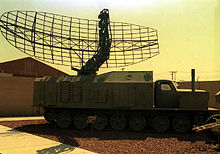- P-40 radar
-
P-40 Radar  P-40 radar at Park Pobedy, Saratov
P-40 radar at Park Pobedy, SaratovCountry of origin  Soviet Union
Soviet UnionIntroduced 1963 Type Early Warning/Target Acquisition Frequency Centimeter Range 370 km Azimuth 360 degrees Elevation 2-14 degrees Power 2 MW The P-40 "Armour" or 1S12 (also referred to by the NATO reporting name "Long Track"in the west) is a 3-D UHF radar developed and operated by the former Soviet Union.
Contents
Development
The P-40 started development in 1960 and by 1962 the radar had completed state trails and in 1963 was accepted into service by the anti-aircraft troops of the Soviet armed forces[1].
In 1965 the P-40 gained the GRAU designation 1S12 as it was adopted as the target acquisition radar of the 2K11 Krug mobile anti-aircraft defence system.
The P-40 was developed by Scientific Research Institute #208 GKRE, which later became known as NIIIP of Minradioprom, OKB-588 (later Lianozovskiy Electromechanical Plant, LEMZ) also assisted in the production of the prototype[1].
Between the 1966 and 1968 the radar was upgraded, increasing the range of the system. Later, between 1969 and 1970, the radars range was again improved in addition to achieving better reliability[1].
Description
The P-40 was the first high-mobility radar to enter into service with the then new tactical anti-aircraft forces of the Soviet armed forces[2].
The P-40 used the AT-T artillery tractor with tracked chassis, fitted with a 12-cylinder 4-stroke diesel engine with an output of 342 kW (465 hp) and producing a top speed of 55 km/h. The P-40 had a crew of 6 and a total weight of 35 tons, the radar being powered by a gas turbine running 400 Hz generator[3].
The radar uses an open frame truncated parabolic antenna with a stacked antenna feed[2]. The radar antenna is mounted on the truck used to transport it giving excellent mobility, the radar capable of being folded for stowage during transit. Azimuth was determined by mechanical scanning while the angle of the target is determined from within which beam of the antenna stack the target is detected[1], the radar does not carry a secondary antenna for IFF.
Operators
The P-40 was operated by the Soviet Union from 1963 and though it has since become obsolete it was passed down to successor states after the fall of the Soviet Union.
See also
External links
http://www.radartutorial.eu/19.kartei/karte912.en.html
References
- ^ a b c d "РЛС П-40 "БРОНЯ"" (in Russian). pvo.guns.ru. 2001-11-23. http://pvo.guns.ru/rtv/p40.htm. Retrieved 2008-12-29.
- ^ a b "Long Track surveillance radar (Russian Federation), Land-based air defence radars". Jane's Radar and Electronic Warfare Systems. 2001-07-02. http://www.janes.com/articles/Janes-Radar-and-Electronic-Warfare-Systems/Long-Track-surveillance-radar-Russian-Federation.html. Retrieved 2009-01-03.
- ^ Christian Wolff (2008). "P- 40 „Long Track”". http://www.radartutorial.eu/19.kartei/karte912.en.html. Retrieved 2009-01-03.
Categories:- Russian and Soviet military radars
Wikimedia Foundation. 2010.

